In the preceding article, I elucidated the method of leveraging ChatGPT, along with other extensive language models, to expedite the procedure of examining customer reviews as a function of customer journey and sentiment. This also includes visualizing the structured data on a dashboard. Subsequently, the model can function as a Customer Experience (CX) consultant, generating insightful recommendations.
In this article, I will delve deeply into analytics and specifically explore the insights that can be directly generated from unsupervised data combining sandsiv+ and OpenAI ChatGPT technologies.
The primary business objective is aptly summarized in the title – we aim to identify potential pitfalls in the customer journey of Disneyland Paris visitors. Our source of information will be the feedback provided directly by customers on Facebook. However, we aspire to progress in two steps: firstly, we aim to auto-generate a list of pros and cons for each customer journey stage. Secondly, we seek to establish a prioritized list of projects that could be implemented to enhance the overall customer experience.
Recall that our dataset comprises a five-star rating and customer commentary. We will extract a wealth of insights from this data, the details of which will unfold in the subsequent sections. Rest assured, there’s a lot in store. So, stay tuned and prepare for some enlightening revelations.
The business goals
Our primary objective is to derive substantial business benefits within 60 seconds instantly. In our scenario, we aim to provide a comprehensive overview of the end-to-end customer journey at a glance, thereby quickly identifying any issues needing correction in processes or otherwise. Moreover, we intend for the model to swiftly recognize the pros and cons of each specific phase of the customer journey, the top suggested improvements, and the required effort. All this information will be incorporated into our dashboard, transforming it into a storytelling tool. This will aid customer experience managers in directing their audience’s attention toward top-tier projects and improvements that must be implemented.
A compelling overview of the entire customer journey
Remember, all insights in this dashboard are derived from just two pieces of data: the star rating given by the customer and their accompanying comments. ChatGPT instantaneously identifies the touchpoint and assigns the topic, sentiment, and star rating. Furthermore, ChatGPT also constructs the phases and touchpoints.
The primary concept of my dashboard is to offer an immediate synopsis of the various phases in the customer journey, the sentiment expressed within each phase, and the star rating assigned. I’ve overlaid the star rating line to give a sense of customer valuation throughout the complete end-to-end journey. Please refer to the snapshot provided be
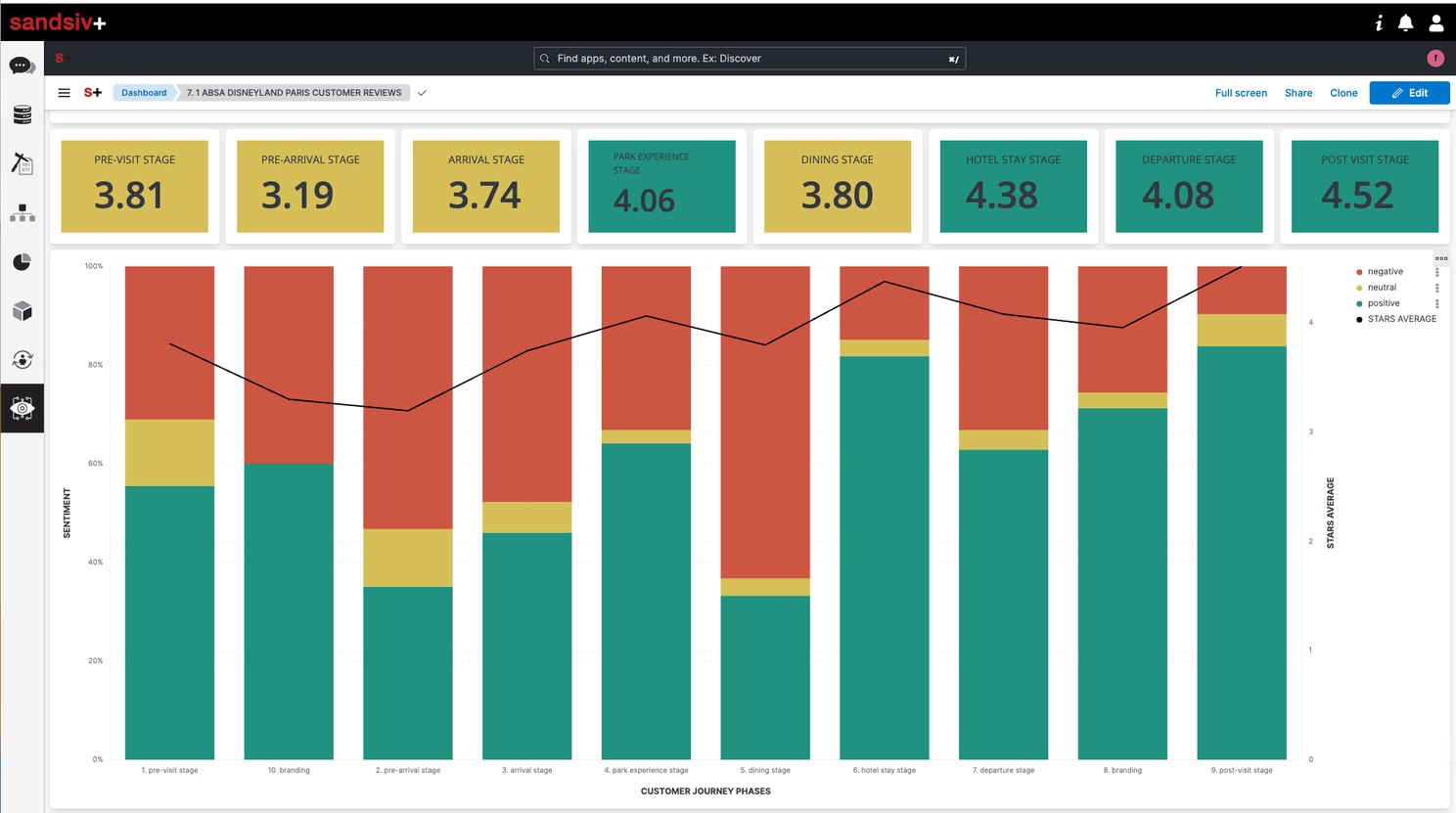 Figure 1 – Overview of the 10 Customer Journey Phases
Figure 1 – Overview of the 10 Customer Journey PhasesWhat insights does this chart offer? According to the sentiment levels, we observe challenges in three specific phases of the Customer Journey:
- the dining
- pre-arrival
- arrival stages
However, on a positive note, the satisfaction level increases throughout the park visit, culminating in the highest score during the post-visit stage. This suggests that the overall end-to-end experience is faring extremely well. Nevertheless, this does not imply that we can’t strive for improvements in the three stages mentioned.

When examining the five-star rating, it is evident that the lowest score is associated with the pre-arrival stage. While the dining stage, with an average of 3.8, does not appear overly concerning, we will investigate both stages to understand and identify potential solutions for each.
Introducing the Customer Experience Interpreter
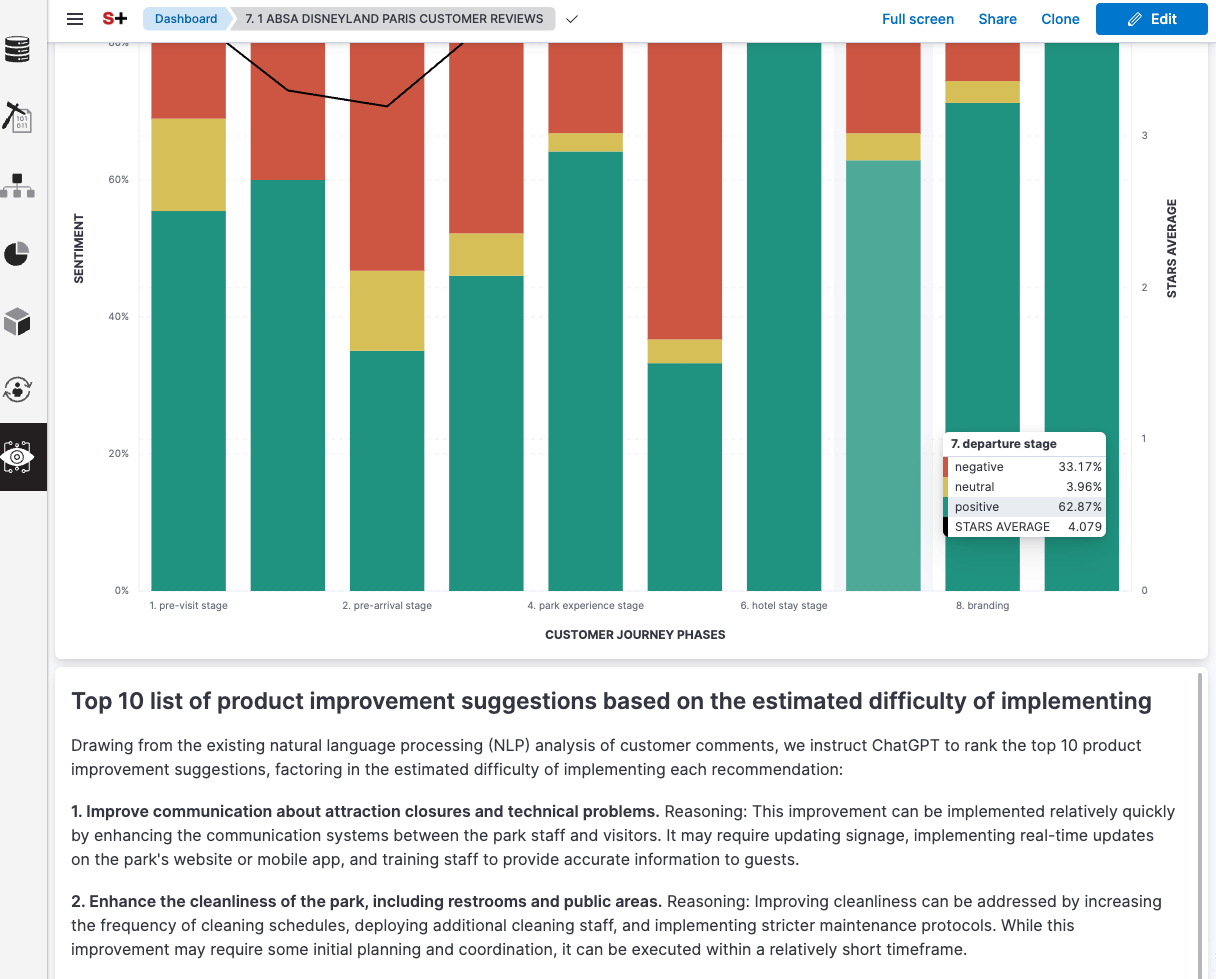
Notice anything unusual about this dashboard? Indeed, apart from the standard features, there’s an entire section dedicated to text. This section isn’t simply a static text field authored by the dashboard creator; it’s a product of a deep data analysis utilizing ChatGPT. I’ll detail the method to generate such an analysis later. However, I must thank Courtin Holt-Nguyen for his preliminary work on extracting actionable insights from customer reviews. While working on this project, I was fortunate that OpenAI launched the new gpt-3.5-turbo-16k. This update enabled me to work on text portions three times larger than what Courtin could handle, thereby allowing me to apply the code efficiently to the entire Disneyland Paris dataset.
The initial promise was to generate initial insights in 60 seconds. Well, I delivered much more. In 60 seconds, ChatGPT and sandsiv+ list the top 10 most critical projects that must be implemented to enhance the park visitors’ experience. These suggestions emerge from a meticulous process that involves analyzing 16,000 customer feedback entries, generating various lists of pros and cons, deducing lists of improvements from these, creating a top 10 list of improvements, prioritizing these based on implementation difficulty for the company, and finally, having the model explain the reasoning behind its decisions. Sounds complex. But I promised to deliver immediately actionable insights in 60 seconds, so I approached this the Steve Jobs way: start with the customer experience, then work backward to the technology. My ultimate goal was to improve the customer experience for my clients, who are primarily customer experience managers. This process reduces their time spent on mundane tasks, allowing them to focus on more valuable actions that significantly impact customer experience.
Let’s review some of the top 10 suggestions derived from the process, including all customer comments. Following this, we’ll delve deeper into specific areas, allowing us to interact graphically with the dashboard and receive specific recommendations in a storytelling format from ChatGPT.
1. Improve communication about attraction closures and technical problems. Reasoning: This improvement can be implemented relatively quickly by enhancing the communication systems between the park staff and visitors. It may require updating signage, implementing real-time updates on the park’s website or mobile app, and training staff to provide accurate information to guests.
As you can observe, ChatGPT ranked this improvement as number 1 overall. But why? The pain of visiting the parks and discovering that certain attractions are closed is undoubtedly an issue numerous clients mention. Enhancing this process would thus improve the overall customer experience. From the company’s perspective, this enhancement is not as challenging to implement as others and can be executed relatively quickly. The model considers all these factors when generating recommendations.
3. Increase the availability of character meet-and-greet opportunities throughout the park. Reasoning: To increase the availability of character meet-and-greet opportunities, the park can schedule additional appearances or allocate more dedicated spaces for interactions. This improvement can be implemented within a moderate timeframe, considering logistical arrangements and coordination with character performers.
This is another recommendation, ranking third on the list based on customer feedback analysis. This is likely an improvement that isn’t too challenging to implement, yet it could generate significant positive customer satisfaction.
Let’s deep dive and check one specific stage of the Customer Journey with a high level of negative sentiment and lower stars rating average: the pre-arrival stage.
Pre-Arrival Stage
The pre-arrival stage has the lowest average five-star rating. On closely examining this stage and its touchpoints, we observe some intriguing patterns: there’s a high proportion of negative feedback within this segment. Upon investigating the specific touchpoints, we find that most clients discuss the reservation and transportation touchpoints. However, the majority of the negative feedback stems from the ticketing touchpoint.
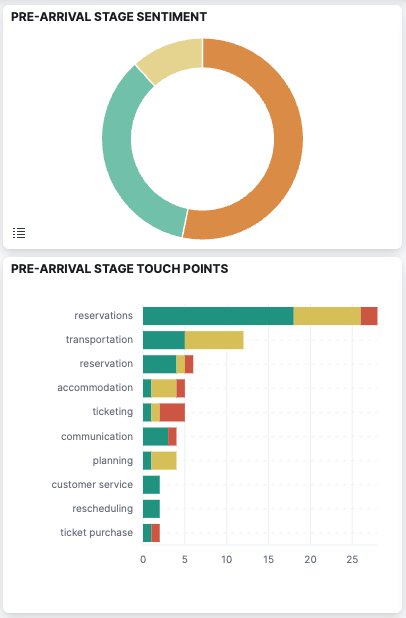
Let’s not forget that all this information is automatically extracted from client feedback by ChatGPT. There’s no need to train models or collect data. All the insights emerge automatically in a zero-shot approach, which makes the process incredibly efficient.
Now, let’s delve deeper into our dashboard and begin interacting with ChatGPT in a more narrative-driven manner. The plan is to feed specific feedback clusters into ChatGPT and retrieve valuable insights in a detailed, narrative format.
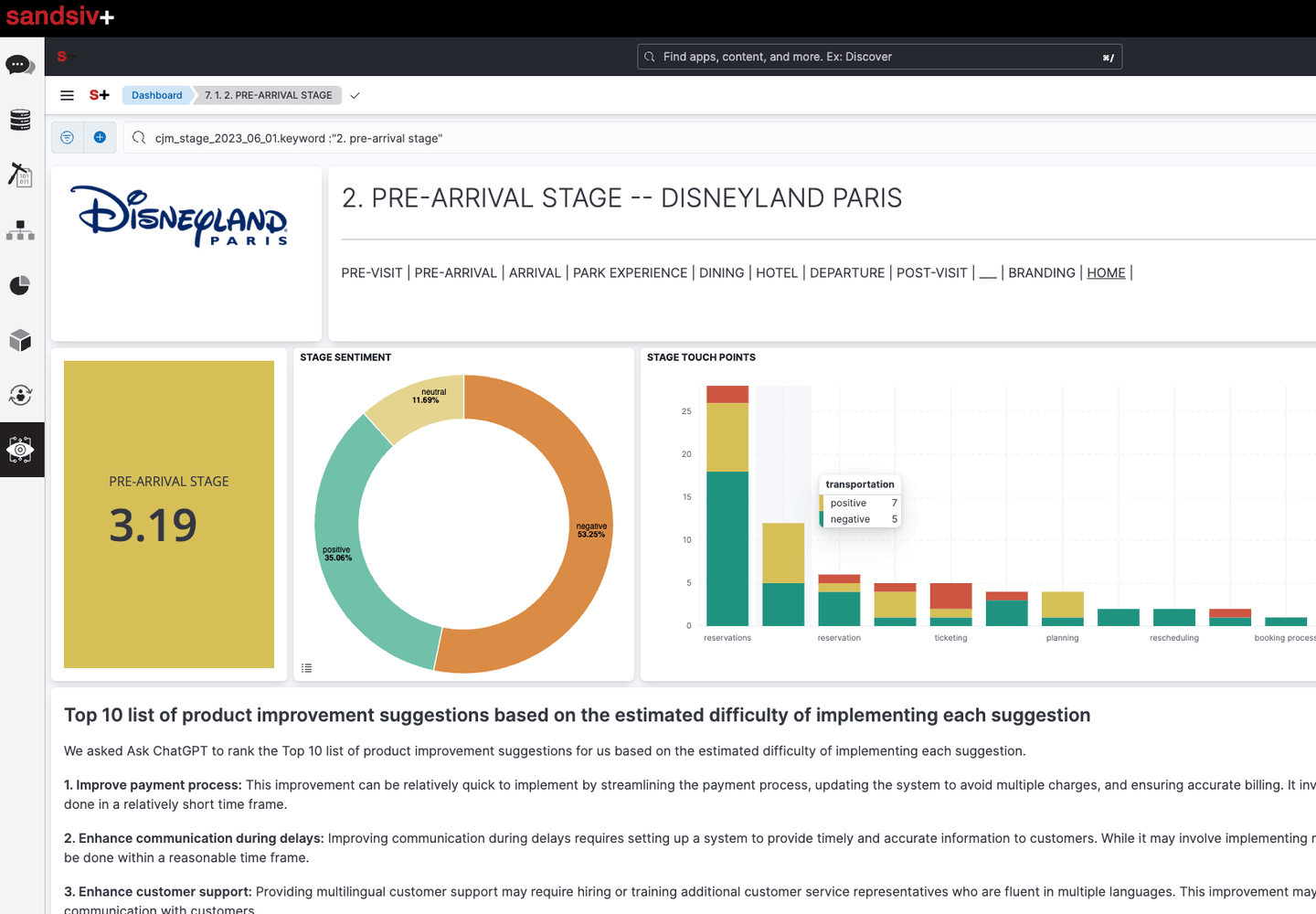
By working with the data, we prompt ChatGPT to generate various analyses. These analyses are designed to provide actionable advice rather than just presenting KPIs the user must interpret independently. This approach aids in creating a more user-friendly and insightful experience. The different analyses are:
1) A list of pros and cons
We engage with the ChatGPT model to process our customer review text data and generate responses through a list of product pros and cons. While some reviews explicitly mention these pros and cons, most do not. Consequently, we rely on ChatGPT’s artificial intelligence capabilities to deduce the product’s strengths and weaknesses from the feedback provided.
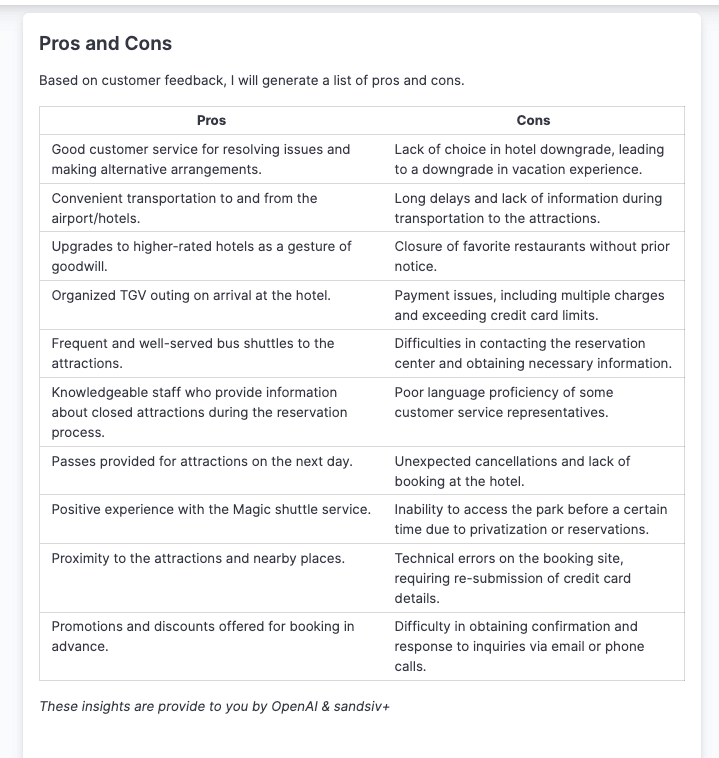
2) We ask ChatGPT to suggest improvements
Understanding how your customers perceive the pros and cons of a product is undoubtedly insightful and valuable. However, your stakeholders will likely follow up with questions like “So what?” and “What can I do with this information?” While intriguing findings can initiate a discussion about customer product feedback, we can strive to offer more. To render our analysis more actionable, we can prompt ChatGPT to suggest potential product enhancements to boost customer satisfaction based on its interpretation of the customer review data.
3) Select The Most Important Product Improvement Suggestions
ChatGPT might generate a lengthy list of product improvement suggestions depending on the number of customer reviews in your dataset. To distill these recommendations into a more manageable format, we can instruct ChatGPT to evaluate the suggestions it created and identify the top 10 most crucial ones.
Based on the various suggestions provided, here are the top 10 improvements that could enhance the overall experience at Disneyland Paris 1. Improve communication about attraction closures and technical problems. 2. Increase the number of open attractions to provide more options for visitors. 3. Enhance the cleanliness of the park, including restrooms and public areas. 4. Offer more variety and affordable options in the park's catering and dining establishments. 5. Reduce waiting times for attractions by improving ride efficiency and capacity. 6. Enhance the FastPass system to reduce waiting times and improve guest experience. 7. Increase the availability of character meet-and-greet opportunities throughout the park. 8. Improve crowd management during peak periods to minimize overcrowding and waiting times. 9. Provide more options for affordable accommodations to cater to a wider range of visitors. 10. Continuously update and introduce new attractions to keep the park fresh and exciting for repeat visitors. Implementing these improvements would address key concerns raised in the reviews and contribute to a more enjoyable and memorable experience for guests at Disneyland Paris.
4) Rank the Top 10 list of product improvement suggestions based on the estimated difficulty of implementing each suggestion
One of the truly captivating features of ChatGPT is its ability to elucidate why it provided a certain response. In our scenario, we’ll prompt ChatGPT to rationalize why it selected these particular product improvements as the most crucial ones. As you’ll observe, ChatGPT assesses each product improvement within the broader context of how a product could boost customer satisfaction, as opposed to merely tallying the number of times a specific type of improvement was mentioned.

5) The Power of ChatGPT AI to Understand And Reason
We’ll ask ChatGPT to rank the top 10 product improvement suggestions based on the estimated difficulty of implementing each recommendation. This is crucial for any company operating with limited resources, as it helps to validate the feasibility of ChatGPT’s improvement suggestions.
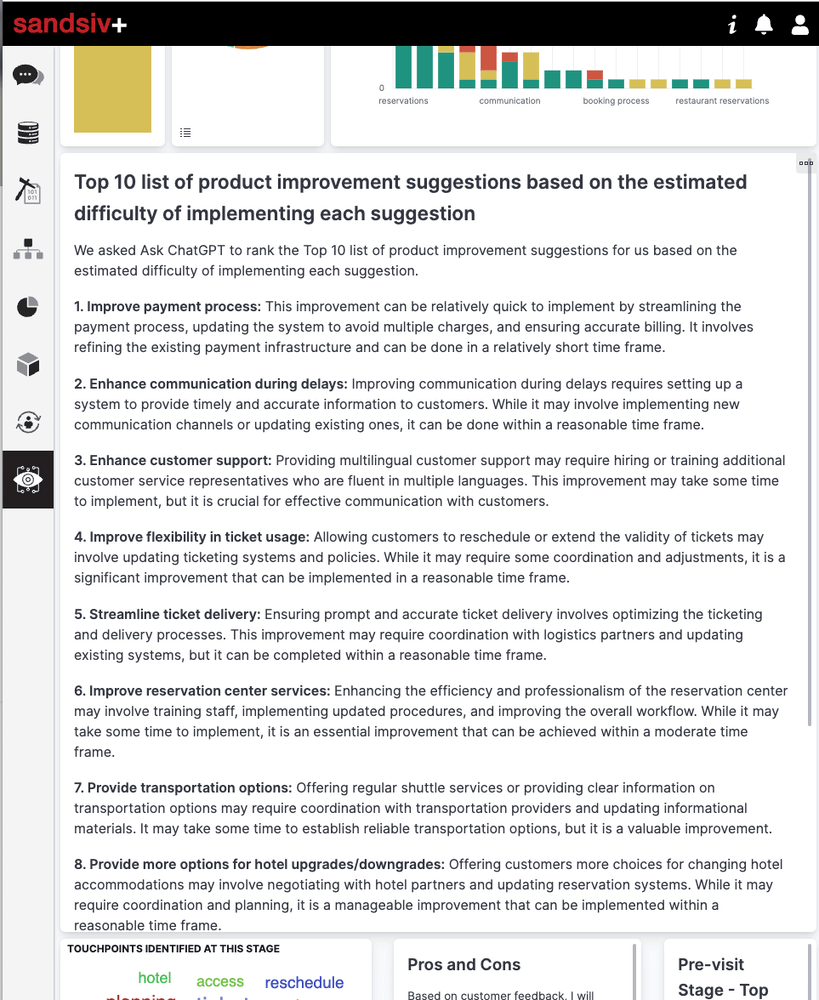
The capabilities of the Customer Experience Interpreter aren’t limited to this. It can be employed across all touchpoints, irrespective of the journey stage. Let’s delve deeper into the specific touchpoints of the PRE-ARRIVAL STAGE.
From Stage to Touchpoints: a logical ChatGPT Interpretation
The pathway from the customer experience stage to the touchpoints involves taking the feedback segments identified by the aspect-based sentiment analysis and asking ChatGPT to pinpoint the touchpoint for that specific segment. Once the touchpoint is identified, we can establish a relationship among the 5-star rating, topic, customer journey stage, and touchpoint.

In the PRE-ARRIVAL STAGE, two touchpoints stand out – transportation and reservation. These touchpoints have been highlighted based on the analysis of customer feedback. We aim to delve deeper into these two critical areas and better understand how they influence the customer journey. By doing this, we hope to glean insights that will enable us to enhance the overall customer experience during the pre-arrival stage at Disneyland Paris.
Touchpoint Analysis: RESERVATION
During the pre-arrival stage of the customer journey, we can delve deeper into analyzing specific touchpoints. In this instance, we’ll focus on the RESERVATION touchpoint. To understand it better, let’s examine the pros and cons associated with this particular touchpoint.
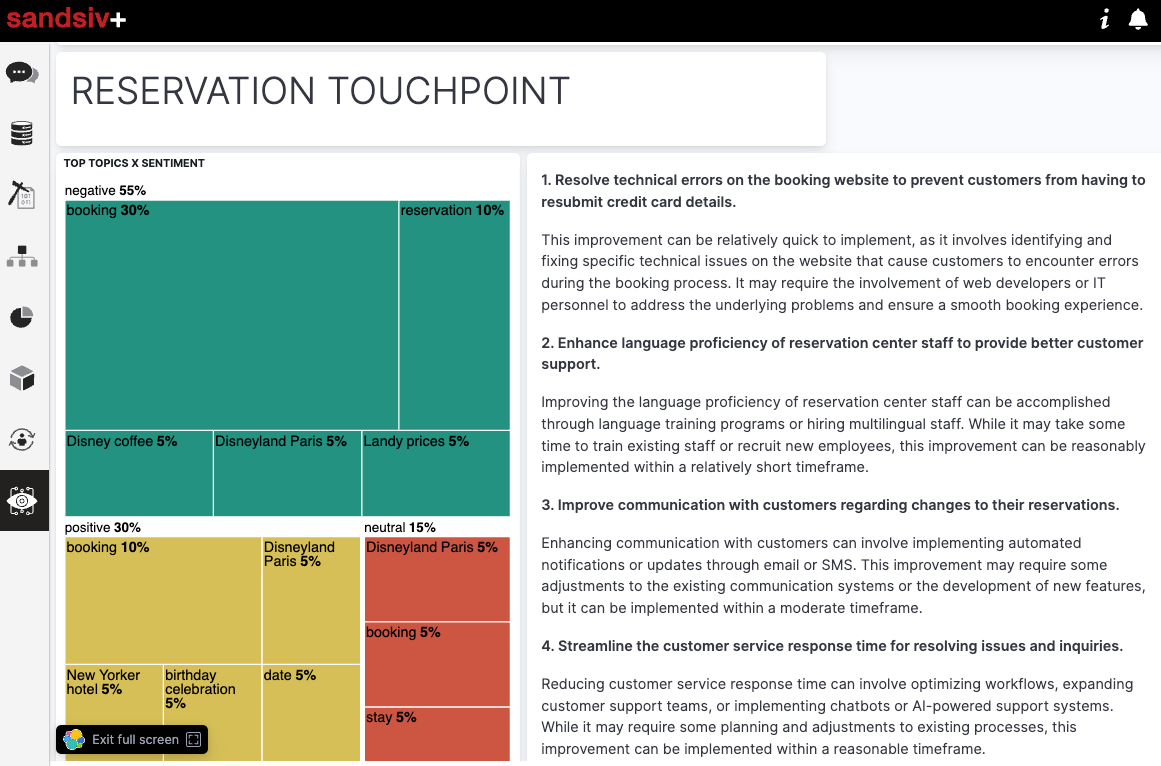
Based on their estimated implementation time, we’ve already ranked the top 10 suggested improvements within the reservation touchpoint. Let’s look at the first suggestion on the list to understand better the insights generated for this specific touchpoint.
1. Resolve technical errors on the booking website to prevent customers from having to resubmit credit card details. This improvement can be relatively quick to implement, as it involves identifying and fixing specific technical issues on the website that cause customers to encounter errors during the booking process. It may require the involvement of web developers or IT personnel to address the underlying problems and ensure a smooth booking experience.
As you can see, the model dives into the specific touchpoints and promptly identifies potential enhancements that could boost customer experience and satisfaction. This targeted analysis is what enables us to devise effective strategies for improvement. Let’s explore another recommendation offered by the model within this advisory list to understand further the depth of insights it provides for improving customer experience.
3. Improve communication with customers regarding changes to their reservations. Enhancing communication with customers can involve implementing automated notifications or updates through email or SMS. This improvement may require some adjustments to the existing communication systems or the development of new features, but it can be implemented within a moderate timeframe.
Indeed, the model’s suggestions for enhancing customer experience in a specific touchpoint are straightforward and concise. Experts dealing with this particular customer journey phase could readily absorb these insights and apply them in practical scenarios, driving tangible improvements.
Touchpoint Analysis: TRANSPORTATION
We’ll now delve deeper into the ‘transportation’ touchpoint, which is linked to the pre-arrival stage and is the second most frequently mentioned area in this stage. Let’s explore it in more detail.
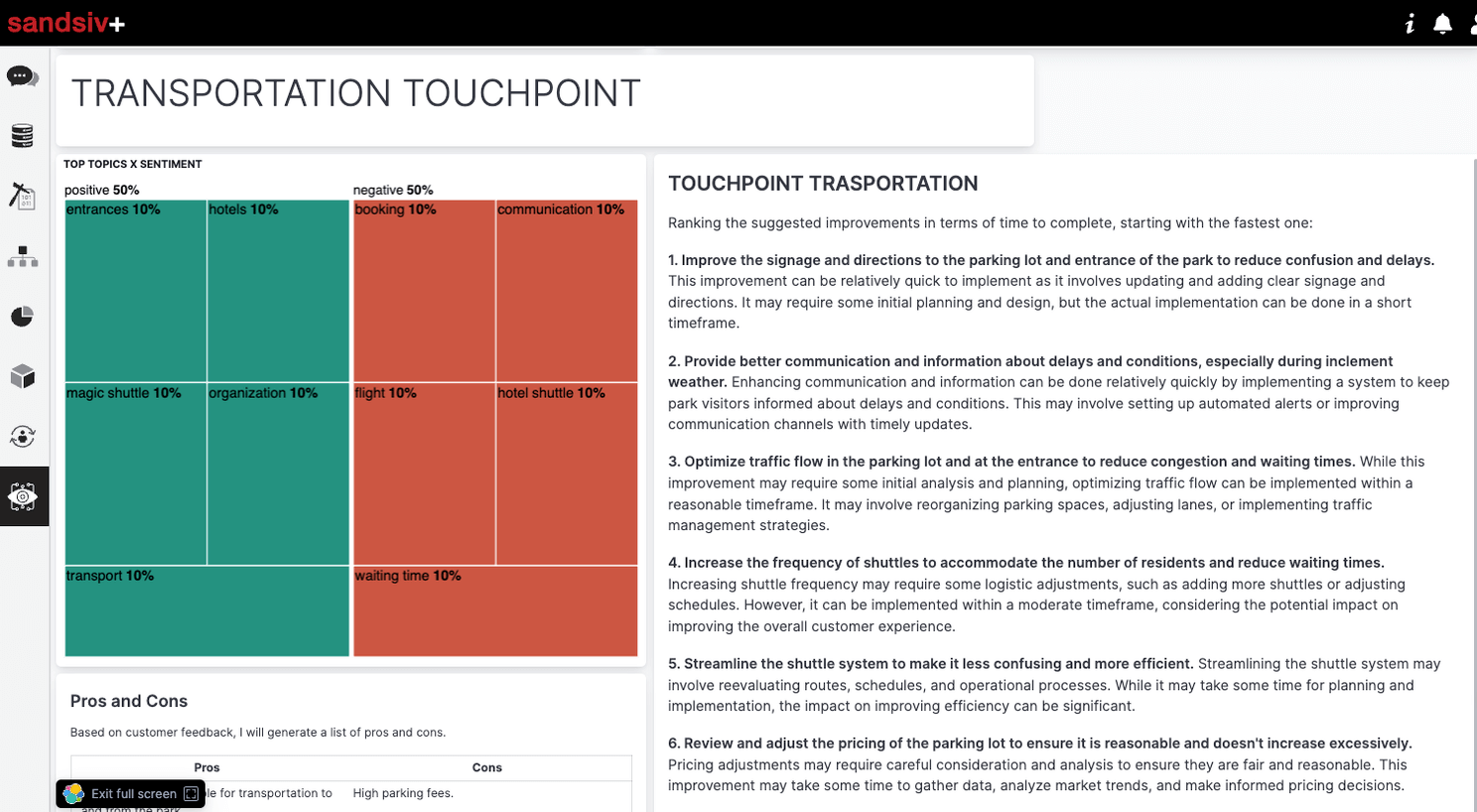
1. Improve the signage and directions to the parking lot and entrance of the park to reduce confusion and delays. This improvement can be relatively quick to implement as it involves updating and adding clear signage and directions. It may require some initial planning and design, but the actual implementation can be done in a short timeframe.
As we wrap up this quick exploration of sandsiv+, let’s turn our attention to the DINING STAGE in the Customer Journey. This stage has been pinpointed as a particular source of negative sentiment, and it’s essential that we delve deeper to grasp the problems that lie within fully.
DINING STAGE
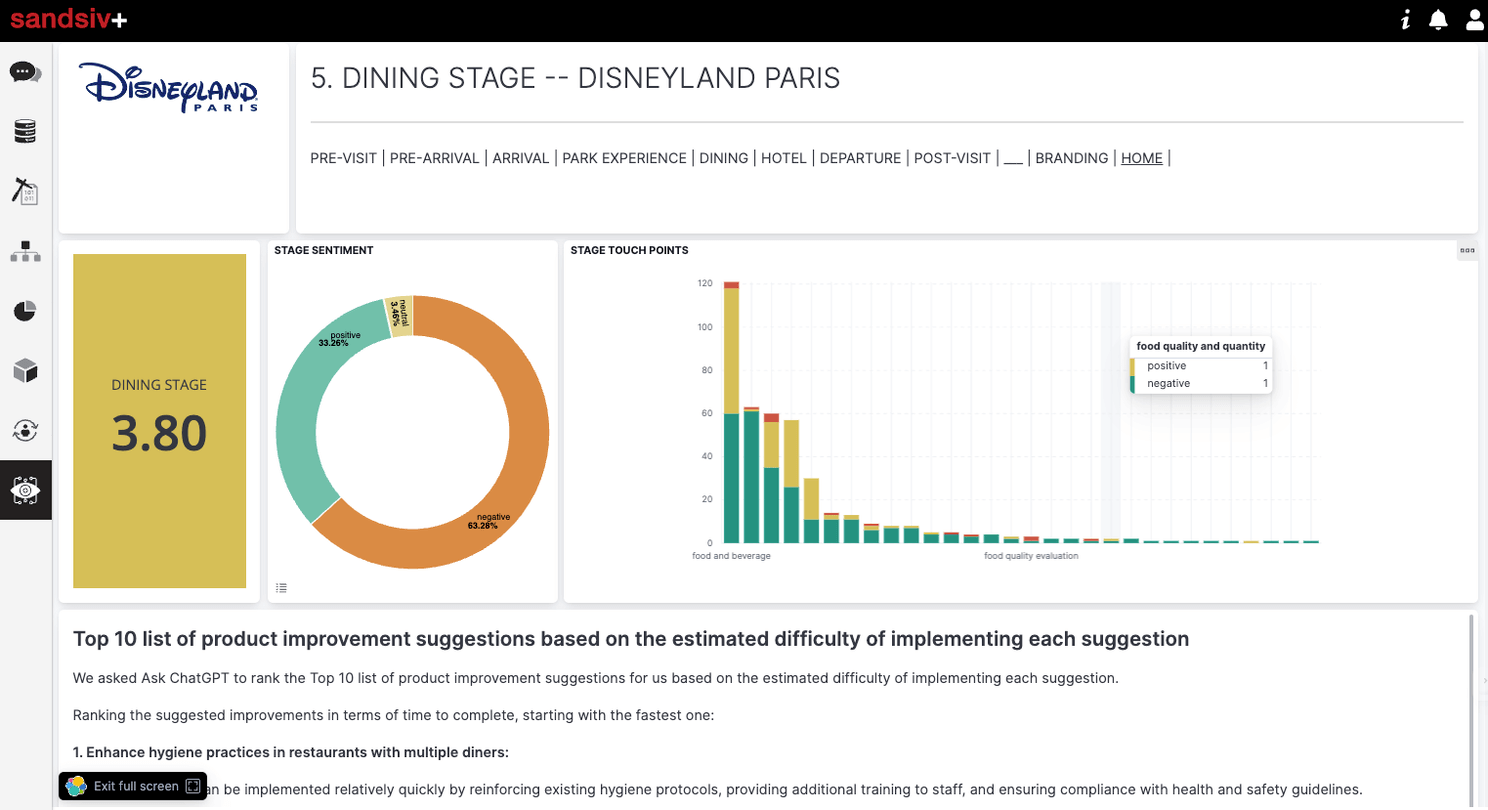
In a stage like DINING, where customer sentiment appears to be negative, having a comprehensive understanding of potential areas of improvement is crucial. By utilizing the insights provided by ChatGPT, we can pinpoint specific issues drawn directly from customer feedback. This data-driven approach can help guide strategic decisions and implement changes that enhance customer experience.
Let’s look at the first recommendation from the ranked list for the DINING stage. This recommendation should provide the most significant potential for improving the customer experience at this stage, according to the analysis conducted by ChatGPT based on the customer feedback data. What specific insights or suggestions does the recommendation provide?
1. Enhance hygiene practices in restaurants with multiple diners: This improvement can be implemented relatively quickly by reinforcing existing hygiene protocols, providing additional training to staff, and ensuring compliance with health and safety guidelines.
If you’re intrigued by how sandsiv+ could analyze your own data and provide specific, actionable insights, just as we’ve demonstrated here with Disneyland Paris, don’t hesitate to contact our sales team. You can schedule a demo or proof of concept using your own data. The only essential requirement is a list of customer feedback. Additional metadata can provide more context and depth, but at its core, sandsiv+ can start working with just your customer feedback. Get in touch and explore how we can transform your approach to customer experience management.
Conclusions
That concludes our deep dive into sandsiv+ and the application of OpenAI’s ChatGPT to analyze customer feedback data and generate insights for Disneyland Paris. We’ve shown how the platform can rapidly identify key touchpoints, derive pros and cons, and suggest improvements – all in a highly readable, narrative format.
This kind of technology transforms our understanding of the customer experience and provides actionable insights for businesses to implement and improve. If you found this new data analysis and dashboarding approach interesting and I’d like to explore it further, don’t hesitate to contact our sales team at sandsiv. We would be more than happy to arrange a live demo for you. Thanks for sticking with us through this fascinating journey into the cutting edge of customer experience analytics.
Remember, every customer’s feedback is a story waiting to be told. With sandsiv+ and ChatGPT, you can now hear those stories loud and clear and take the necessary actions to ensure an ever-improving experience for your customers.
